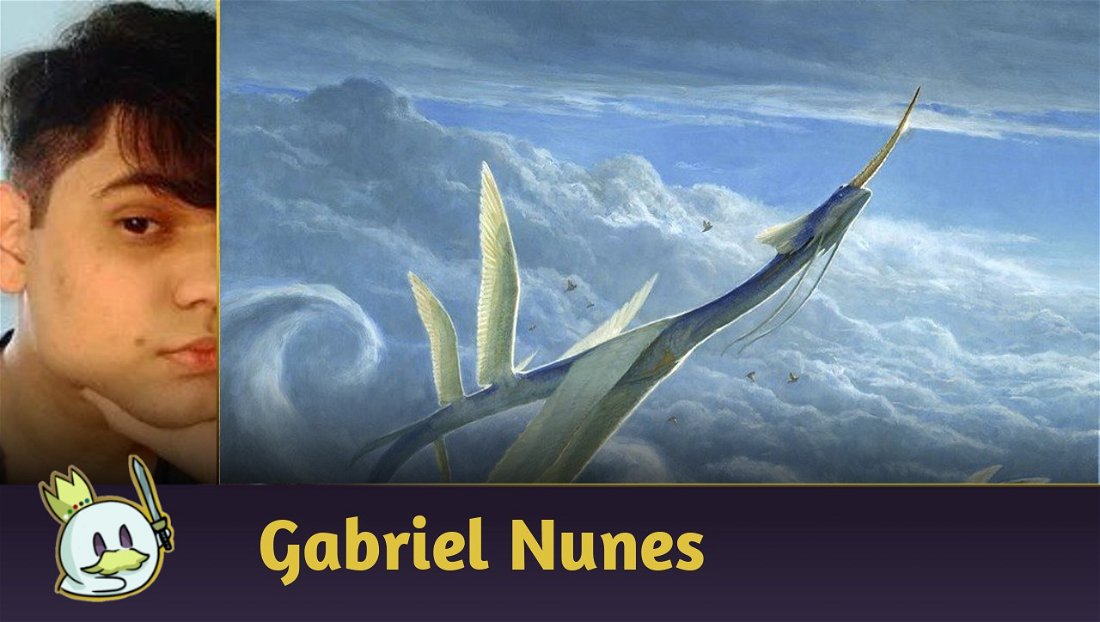Going straight to the facts, Azorius Control was the most played deck on SCGCon Indianapolis' Pioneer portion, which took place this past weekend, while also being one of the most representative archetypes in the Challenges' Top 32, including three Top 8 placements on March 19th.
In other words, all the evidence points to a notorious rise of the most classic Control of the format to the top of the Metagame, where it probably won't leave for the next few weeks, as some of the best inclusions from Kamigawa: Neon Dynasty work incredibly well on the list.
What is Azorius Control?
In case you're wondering what Azorius Control is all about, the deck is essentially your classic "Draw-Go", which utilizes low-cost 1-for-1 disruptions and trades like Portable Hole and Censor at the beginning of the game to extend it to the point where the opponent's mana investment is obsolete against cards like Absorb and Fateful Absence. That's to the point where the player starts accumulating rivers of Card Advantage with 2-for-1 effects like Supreme Verdict, or through powerful Planeswalkers such as The Wandering Emperor and Teferi, Hero of Dominaria.

From this point on, Azorius Control reaches inevitability and begins to overwhelm the opponent in value and card advantage, while its more proactive plays may involve giant Shark Typhoon tokens, or Hall of Storm Giants to close the match when all the opponent's resources have been properly neutralized, or become scarce.

One of the advantages that Azorius Control has compared to the other variants is the amount of universally effective answers that its lists tend to have, being useful against both creatures and Planeswalkers or artifacts and enchantments, while other variants, such as the Dimir, need to separate their choices as needed for the expected Metagame.

Conditional spells, such as Dovin's Veto on the maindeck or Rest in Peace on the sideboard, are also significantly better than needing to resort to Negate or Thoughtseize for a Control mirror, or requiring Leyline of the Void, Soul-Guide Lantern or Graveyard Trespasser against Izzet Phoenix. All this while Azorius still retains the most important blue pieces, such as Aether Gust or Hullbreaker Horror, making it a significantly superior version over other Control options and, apparently, also making it one of the best decks in the format.
Causes of its Ascension
However, this rise did not happen overnight, and a sequence of factors contributed to Azorius reaching the top of the Metagame in these last few weeks:
Kamigawa: Neon Dynasty brought great cards to this strategy

Kamigawa: Neon Dynasty brought three very indispensable cards for a Control strategy.
The Wandering Emperor is considered one of the top ten Planeswalkers ever released in the game, and her ability to be cast with Flash and perform an effect makes it a perfect play that balances proactive and reactive for an archetype which wants, on most occasions, take the game in a reactive way, always considering what the opponent intends to do before making its own move. In addition to also being responsible for the Azorius mirrors not only being dictated by resources' accumulation, but also by the damage that a The Wandering Emperor solved in the End Step, or as a bait to cast something more impactful in the next turn, creating new play openings for both players.
March of Otherworldly Light, as I mentioned in my Pioneer set review, is so individually powerful that it can easily be compared to Prismatic Ending, with the notable exception that it doesn't demand a high color requirement, but rather a higher mana requirement to work against the most diverse situations. Having a removal that can handle both creatures and other categories of permanents for a relatively “low” cost for a Draw-Go is a huge advantage in flexing slots on the Maindeck and Sideboard.
Finally, Farewell, despite having a relatively high cost, manages to clear the board (and through an exile effect, essential for matchups like Izzet Phoenix or Cat-Oven) of basically any threat that isn't a Planeswalker, making it a perfect sweeper for the strategy proposed by Azorius Control.
Lurrus is Banned
Pioneer suffered an abrupt earthquake with the latest banned and restricted announcement that deprived the format of one of the most powerful creatures in Magic: The Gathering history, Lurrus of the Dream-Den, altering the Metagame's structure and rebalancing the format in order to no longer invalidate a category of cards that severely punish the high investment of mana to cast spells, such as removals and counterspells, opening more space for "answer" archetypes, precisely the category in which Azorius Control is found.

With decks that benefited from a low mana investment taking a huge hit from the last ban, we've seen the rise of archetypes like Naya Winota, Niv-to-Light, and Rakdos Midrange, which runs higher-cost cards, making 1-for-1 trades with Censor and Absorb advantageous, while lists that took advantage of low costs are notoriously more absent from the competitive landscape now.
It's the best Narset deck

One strategy that rose again with the absence of Lurrus of the Dream-Den and the decrease in Oni-Cult Anvil was Izzet Phoenix, which was considered the best deck in the format before Neon Dynasty and is still extremely popular, as well as still being present a Tier 1, and one of the most punishing cards to play against it, and also against the mirror match is Narset, Parter of Veils — which essentially demands an immediate answer, or the need to play a lot around cards so as not to be overwhelmed by the advantage established by the Planeswalker being present on the board.
Azorius Control can utilize Narset better than any other Blue-Based Deck currently, as not only does it have several valid targets for her ability, it also cares little about paying three mana to get two Impulse with a disruption attached over two turns.
It is one of the decks that best manages to operate similarly to its Modern variant

If we look closely, we can see that Azorius Control's slots and plays in Pioneer essentially follows the same basis that was and still is used by it in Modern. Of course, we don't have access to staples like Solitude, Jace, the Mind Sculptor or Snapcaster Mage, other than more well-established options in the format like Cryptic Command, but We have access to numerous engines and cards that are equally powerful in both formats, such as Narset, Parter of Veils and Teferi, Hero of Dominaria with new parts such as Hall of Storm Giants, which gives a good Celestial Colonnade impression.
That is, Pioneer's Azorius Control manages to operate at almost the same scale that its pre-MH2 Modern version used to play. Something that not only offers an excellent shell, but is also a huge draw for players to want to test and play with the archetype.
How to play well against Azorius Control?
Force the 2-for-1

Playing with cards that force the opponent to spend more resources than intended, and where every creature that comes into play is naturally a threat is a way to gain a significant advantage against Control, eventually forcing unfavorable trades.
Creatures and other permanents that offer some additional advantage, such as Elite Spellbinder's hand disruption, or a considerable power boost on the board, such as Esika's Chariot, are ideal candidates for hampering the efficiency of the player's trades. So, I think decks like Naya Winota and Humans (with access to Kitesail Freebooter and Elite Spellbinder) can take advantage of this weakness to establish an advantage.
Spirits variants can also establish this advantage, especially with access to Mystical Dispute on the Sideboard, but I'm guessing it's the least aggressive archetype among them and most reliant on specific cards to operate, while the other two creature-based have numerous creatures that are incredibly good on their own.
Be disruptive, I mean... be very disruptive

A Black-based deck with a good base of discards and other disruptions alongside an efficient clock can destabilize Azorius for long enough to close the game, or even accumulate more resources and value than them, depending on your plays.
One of my favorites means of doing this are based on combining efficient discard effects like Thoughtseize and Go Blank alongside effects that let you recast such spells, like Bloodthirsty Adversary, coupled with means of resorting to your threats, such as Kolaghan's Command (and previously Lurrus of the Dream-Den). This combination, when well constructed, creates a disruption cycle so powerful that often the opponent will be short of resources, forcing them to stretch or rush some plays, so they don't get outvalued
Protect your threats

Azorius Control tries to benefit from 1-for-1 trades to establish the game in the first few turns, and often requires a greater mana investment to be able to respond to more than one threat at a time.
So, if you manage to establish one or more threats and protect it with counterspells or protection effects like Gods Willing, or with discard spells like Thoughtseize, it's likely that Azorius will have a hard time establishing itself quickly enough to lower its clock, which can even be complemented with Manlands to escape sweepers during the game.
Ignore it and be faster
Dedicated combos have the efficient tools to prevent Azorius Control from being able to establish itself before you close the combo, or the mere possibility of you threatening to close the combo during repeated turns already makes the archetype need to play too far back, offering it virtual Time Walks that can be used to create bluffs or notoriously unexpected plays that will make the opponent have to think twice or thrice before deciding to counter a spell or remove a permanent.
I believe that, among the current combo decks, Lotus Field is the most efficient list to play against Azorius Control as its main threat has a built-in protection and is not an easy target for March of Otherworldly Light, as is the case with Jeskai Ascendancy, in addition to its mana abundance, it can also be used to cast threats from the maindeck or sideboard that make it possible to play around the opponent's game plan.
Conclusion
That's all for today. I think it's possible to imagine that Azorius Control will maintain its position in the format for a few more weeks until the Metagame settles against it. And even in this situation, I believe that it will still be present as one of the main competitors of the format, for having a very well elaborated structure and with a series of individually powerful cards.
It is not possible to say, yet, that it is Pioneer's best strategy: we observed several other archetypes making results in the Top 8 and Top 16 of the Challenges, including some innovations involving Fable of the Mirror-Breaker, which seems to be becoming a staple, as well as other well-established options that produce good results, such as Izzet Phoenix, Lotus Combo, Rakdos Midrange, among others that manage to keep up with the Metagame.
Thanks for reading!














— Comments 0
, Reactions 1
Be the first to comment